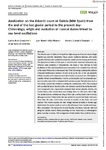Mostrar o rexistro simple do ítem
Aeolization on the Atlantic Coast of Galicia (NW Spain) From the End of the Last Glacial Period to the Present Day: Chronology, Origin and Evolution of Coastal Dunes Linked to Sea-Level Oscillations
| dc.contributor.author | Arce-Chamorro, Carlos | |
| dc.contributor.author | Vidal Romaní, Juan Ramón | |
| dc.contributor.author | Grandal-d'Anglade, Aurora | |
| dc.contributor.author | Sanjurjo-Sánchez, Jorge | |
| dc.date.accessioned | 2023-01-17T19:57:48Z | |
| dc.date.available | 2023-01-17T19:57:48Z | |
| dc.date.issued | 2022-10-05 | |
| dc.identifier.citation | Arce Chamorro, C., Vidal Romaní, J.R., Grandal d'Anglade, A. & Sanjurjo Sánchez, J. (2023) Aeolization on the Atlantic coast of Galicia (NW Spain) from the end of the last glacial period to the present day: Chronology, origin and evolution of coastal dunes linked to sea-level oscillations. Earth Surface Processes and Landforms, 48(1), 198– 214. Available from: https://doi.org/10.1002/esp.5481 | es_ES |
| dc.identifier.issn | 1096-9837 | |
| dc.identifier.uri | http://hdl.handle.net/2183/32360 | |
| dc.description | Financiado para publicación en acceso aberto: Universidade da Coruña/CISUG | es_ES |
| dc.description.abstract | [Abstract] The Atlantic coast of Galicia (NW Spain) is a high-energy environment where shingle beaches are currently developing. These coarser sediments alternate with sandy deposits which are also considered as beaches typical of a low-energy environment. The physical association of both types of sediment with contrasted sedimentary significance raises problems of interpretation. The study of four outcrops of fossil aeolianites on this coast has allowed us to reconstruct their evolution from the end of the Upper Pleistocene to the present day. Their chronology, estimated by optically stimulated luminescence between 35 and 14 ky at the end of the last glaciation (MIS2), coincides with a local sea level 120 m below the present one. This implies a coastline shifted several kilometres from its current location and the subaerial exposure of a wide strip of the continental shelf covered by sands. The wind blew sand to form dunes towards the continent, covering the coastal areas, which then emerged with no other limitation than the active river channels. Sea-level rise during the Holocene transgression has progressively swamped these aeolian deposits, leaving only flooded dunes, relict coastal dunes and climbing dunes on cliffs up to 180 m high. The aeolian process continued as long as there was a sandy source area to erode, although accretion finished when the sea reached its current level (Late Holocene). Since then, the wind turned from accretion to erosion of the dunes and sand beaches. This erosion exposes the older shingle beaches (probably of Eemian age) buried under the aeolian sands, as well as old, submerged forest remains and megalithic monuments. The destruction of sand beaches and dunes currently observed along the Galician coast is linked, according to most researchers, to anthropogenic global warming. However, their management should consider these evolutive issues. | es_ES |
| dc.description.sponsorship | This research has been funded and supported by Consellería de Cultura, Educación e Ordenación Universitaria, Xunta de Galicia (programmes ED431B 2018/47 and ED431B 2021/17) through the Grupo Interdisciplinar de Patrimonio Cultural e Xeolóxico (CULXEO). Thanks to Universidade da Coruña/Consorcio Interuniversitario del Sistema Universitario de Galicia (CISUG) for Open Acces funding | es_ES |
| dc.description.sponsorship | Xunta de Galicia; ED431B 2018/47 | es_ES |
| dc.description.sponsorship | Xunta de Galicia; ED431B 2021/17 | es_ES |
| dc.language.iso | eng | es_ES |
| dc.publisher | Wiley | es_ES |
| dc.relation.uri | https://doi.org/10.1002/esp.5481 | es_ES |
| dc.rights | Atribución 4.0 Internacional | es_ES |
| dc.rights.uri | http://creativecommons.org/licenses/by/4.0/ | * |
| dc.subject | Aeolian accretion | es_ES |
| dc.subject | Coastal aeolianites | es_ES |
| dc.subject | Glacioeustasy | es_ES |
| dc.subject | NW Spanish Atlantic coast | es_ES |
| dc.subject | Optically stimulated luminescence | es_ES |
| dc.subject | Upper Pleistocene and Holocene | es_ES |
| dc.title | Aeolization on the Atlantic Coast of Galicia (NW Spain) From the End of the Last Glacial Period to the Present Day: Chronology, Origin and Evolution of Coastal Dunes Linked to Sea-Level Oscillations | es_ES |
| dc.type | journal article | es_ES |
| dc.rights.accessRights | open access | es_ES |
| UDC.journalTitle | Earth Surface Processes and Landforms | es_ES |
| UDC.volume | 48 | es_ES |
| UDC.issue | 1 | es_ES |
| UDC.startPage | 198 | es_ES |
| UDC.endPage | 214 | es_ES |
| dc.identifier.doi | 10.1002/esp.5481 | |
| UDC.coleccion | Investigación | es_ES |
| UDC.departamento | Física e Ciencias da Terra | es_ES |
| UDC.grupoInv | Grupo Interdisciplinar de Patrimonio Cultural e Xeolóxico (CULXEO) | es_ES |
| UDC.institutoCentro | Instituto Universitario de Xeoloxía Isidro Parga Pondal | es_ES |
Ficheiros no ítem
Este ítem aparece na(s) seguinte(s) colección(s)
-
Investigación (FCIE) [1227]






